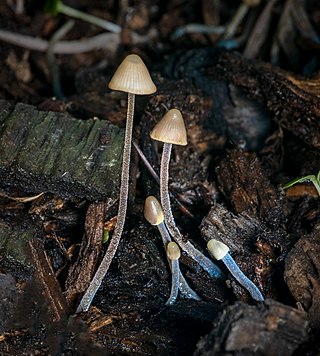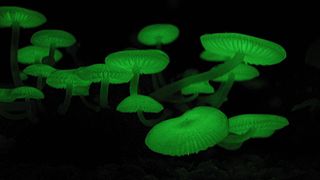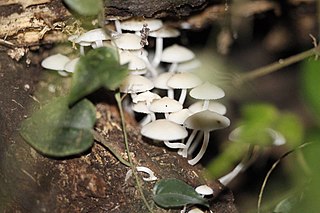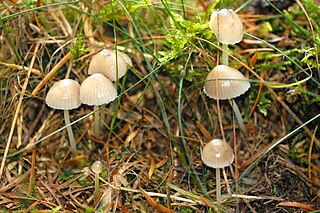
In fungi, a basidiocarp, basidiome, or basidioma (pl. basidiomata) is the sporocarp of a basidiomycete, the multicellular structure on which the spore-producing hymenium is borne. Basidiocarps are characteristic of the hymenomycetes; rusts and smuts do not produce such structures. As with other sporocarps, epigeous (above-ground) basidiocarps that are visible to the naked eye are commonly referred to as mushrooms, while hypogeous (underground) basidiocarps are usually called false truffles.

Mycena is a large genus of small saprotrophic mushrooms that are rarely more than a few centimeters in width. They are characterized by a white spore print, a small conical or bell-shaped cap, and a thin fragile stem. Most are grey or brown, but a few species have brighter colours. Most have a translucent and striate cap, which rarely has an incurved margin. The gills are attached and usually have cystidia. Some species, like Mycena haematopus, exude a latex when the stem is broken, and many species have a chlorine or radish-like odour.

Roridomyces roridus, commonly known as the dripping bonnet or the slippery mycena, is a species of agaric fungus in the family Mycenaceae. It is whitish or dirty yellow in color, with a broad convex cap 5–15 mm (0.2–0.6 in) in diameter. The stipe is covered with a thick, slippery slime layer. This species can be bioluminescent, and is one of the several causative species of foxfire.

Mycena haematopus, commonly known as the bleeding fairy helmet, the burgundydrop bonnet, or the bleeding Mycena, is a species of fungus in the family Mycenaceae, of the order Agaricales. It is widespread and common in Europe and North America, and has also been collected in Japan and Venezuela. It is saprotrophic—meaning that it obtains nutrients by consuming decomposing organic matter—and the fruit bodies appear in small groups or clusters on the decaying logs, trunks, and stumps of deciduous trees, particularly beech. The fungus, first described scientifically in 1799, is classified in the section Lactipedes of the genus Mycena, along with other species that produce a milky or colored latex.

Mycena sanguinolenta, commonly known as the bleeding bonnet, the smaller bleeding Mycena, or the terrestrial bleeding Mycena, is a species of mushroom in the family Mycenaceae. It is a common and widely distributed species, and has been found in North America, Europe, Australia, and Asia. The fungus produces reddish-brown to reddish-purple fruit bodies with conic to bell-shaped caps up to 1.5 cm (0.6 in) wide held by slender stipes up to 6 cm (2.4 in) high. When fresh, the fruit bodies will "bleed" a dark reddish-purple sap. The similar Mycena haematopus is larger, and grows on decaying wood, usually in clumps. M. sanguinolenta contains alkaloid pigments that are unique to the species, may produce an antifungal compound, and is bioluminescent. The edibility of the mushroom has not been determined.

Mycena stylobates, commonly known as the bulbous bonnet, is a species of inedible mushroom in the family Mycenaceae. Found in North America and Europe, it produces small whitish to gray fruit bodies with bell-shaped caps that are up to 15 mm (0.6 in) in diameter. The distinguishing characteristic of the mushroom is the fragile stipe, which is seated on a flat disk marked with distinct grooves, and fringed with a row of bristles. The mushrooms grow in small troops on leaves and other debris of deciduous and coniferous trees. The mushroom's spores are white in deposit, smooth, and ellipsoid-shaped with dimensions of 6–10 by 3.5–4.5 μm. In the development of the fruit body, the preliminary stipe and cap structures appear at the same time within the primordium, and hyphae originating from the stipe form a cover over the developing structures. The mycelia of the mushroom is believed to have bioluminescent properties.

Omphalotus subilludens, commonly known as the Southern Jack O'lantern mushroom, is a basidiomycete fungi in the genus Omphalotus. It has been definitively recorded in Florida and Texas with reports of species in Arizona and Mexico. It fruits on dead and dying trees during warmer parts of the year, producing a fairly large orange to brown-orange fruiting body that occurs in clusters. It's most closely related to O. olivascans, O. olearius, and O. japonicus and has high cross compatibility with O. olivescans and O. olearis. It is poisonous to humans and animals when eaten but rarely produces life-threatening symptoms, usually poisonings are resolved in 24-48 hours, with the majority of symptoms being gastrointestinal. Compounds in these mushrooms have pharmacological potential with potential applications in anti-coagulants, cancer therapies, and antibiotics. It is also bioluminescent producing a faint glow around the gills through the oxidation of luciferase.

Mycena chlorophos is a species of agaric fungus in the family Mycenaceae. First described in 1860, the fungus is found in subtropical Asia, including India, Japan, Taiwan, Polynesia, Indonesia, and Sri Lanka, in Australia, and Brazil. Fruit bodies (mushrooms) have pale brownish-grey sticky caps up to 30 mm (1.2 in) in diameter atop stems 6–30 mm (0.2–1.2 in) long and up to a millimeter thick. The mushrooms are bioluminescent and emit a pale green light. Fruiting occurs in forests on fallen woody debris such as dead twigs, branches, and logs. The fungus can be made to grow and fruit in laboratory conditions, and the growth conditions affecting bioluminescence have been investigated.
Mycena asterina is a species of agaric fungus in the family Mycenaceae. It is found in São Paulo state, Brazil, where it grows singly or scattered on fallen leaves in Atlantic forests. The fruit bodies of the fungus are bioluminescent.
Mycena discobasis is a species of agaric fungus in the family Mycenaceae. Found in South America and Madagascar, the fruit bodies of the fungus are bioluminescent.
Mycena fera is a species of agaric fungus in the family Mycenaceae. Found in South America, the fruit bodies of the fungus are bioluminescent.

Mycena illuminans is a species of agaric fungus in the family Mycenaceae. It was first found on the trunk of Calamus (palm) in Jawa, Indonesia. It is bioluminescent.

Mycena singeri is a species of agaric fungus in the family Mycenaceae. Described as new to science in 1988 by Jean Lodge, it is bioluminescent. In 2007, the first reported luminescent species were found from a single site in primary Atlantic Forest habitat in the Alto Ribeira Tourist State Park, São Paulo State, Brazil.

Mycena olivaceomarginata is a species of agaric fungus in the family Mycenaceae. Originally described as Agaricus olivaceomarginata by English mycologist George Edward Massee in 1890, he transferred it to Mycena in 1893. Found in Europe and North America, the mycelium of the fungus is bioluminescent.
Mycena noctilucens is a species of agaric fungus in the family Mycenaceae. The species was first described scientifically by E.J.H. Corner in 1954. Found in Malaysia and the Pacific islands, the mycelium of the fungus is bioluminescent.

Mycena manipularis is a species of agaric fungus in the family Mycenaceae. Found in Australasia, Malaysia, and the Pacific islands, the mycelium and fruit bodies of the fungus grow in forests and can be bioluminescent. The fruiting bodies also display a variety of morphologies that have no current genetic attributions. References to Mycena manipularis can be found in Japanese folklore and Indonesian food culture.
Roridomyces irritans is a species of fungus in the genus Roridomyces, family Mycenaceae. Originally described from New Caledonia as Mycena irritans by Egon Horak in 1978, the species was transferred to Roridomyces in 1994. The fruit bodies are bioluminescent.

Borofutus is a fungal genus in the family Boletaceae. Newly described in 2012, it is monotypic, containing the single species Borofutus dhakanus, found in tropical Asia. The generic name Borofutus derives from the Bengali language, and means "large pore", while dhakanus refers to the type locality in Gazipur, Dhaka Division, Bhawal National Park, in Bangladesh. Molecular analysis shows Borofutus to be closely related to Spongiforma.
Mycena nebula is a species of fungus belonging to the Mycena genus. It was discovered in Veracruz in Mexico growing on moss-covered bark on living trees. It was documented in 2019 by A. Cortés-Pérez, Desjardin, and A. Rockefeller.












